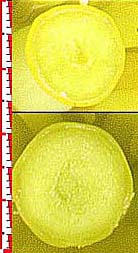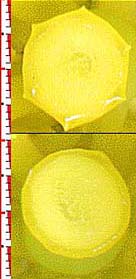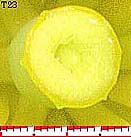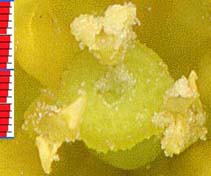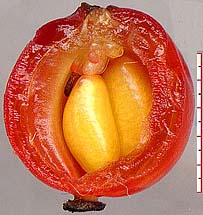Berberis Gynoecium Morphology
by Bob Harms

Our two species have a number of significant differences in the form and size of various gynoecium components, with individual hybrids sometimes closer to one or the other of the two species, but generally not intermediate with respect to form or size.
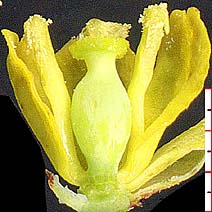 |
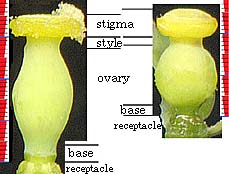 |
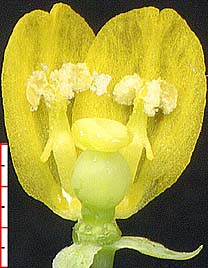 |
| B. trifoliolata |
B. trifoliolata & B. swaseyi Pistils |
B. swaseyi |
The Ovary
Most strikingly different is the ovary at anthesis as well as with mature fruits.
At anthesis B. trifoliolata's ovary is broadly elliptic and longer; B. swaseyi's is subglobose and short - as may be noted in the above images. Individual hybrids tend to exhibit either one of these two patterns.
| |
B. trifoliolata
|
B. swaseyi
|
| | Ovary
length | Ovary
width | Length-breadth
ratio | Ovary
length | Ovary
width | Length-breadth
ratio |
| ranges | 1.9 to 2.9 | 1.25 to 1.64 | 1.3 to 1.8 | 1.4 to 1.88 | 1.2 to 1.83 | 0.8 to 1.4 |
| averages | 2.3 | 1.4 | 1.6 | 1.6 | 1.5 | 1.1 |
Mature carpels reverse the size difference, and the form is not consistently distinctive. B. trifoliolata is much smaller and most commonly globose; B. swaseyi, typically flattened on one or both ends. Both have a well defined grove at the dorsal trace. The potential hybrid, T23, (see "Stigma" below) has fruits that are roughly intermediate in size. Fruit size is one feature that produces intermediate results for the clear hybrids, but all have significantly larger fruits than B. trifoliolata.
The central depression connects with the inner surface of the style, a solid continuum of papillose tissue as an extension of the dorsal trace. When older, dissection of this area generally produces an open canal into the carpel. The papillosity extends relatively farther into the carpel with B. trifoliolata, which also has a more strongly developed dorsal trace. (Payer's 1857 drawing of a dissected B. repens ovary (Pl. 52, Fig. 25) shows the stigma depression forming an opening into the ovary covered with papillae, and extending much lower into the carpel than we have noted with B. trifoliolata.)
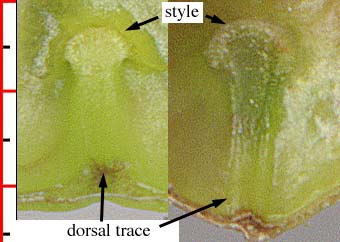 |
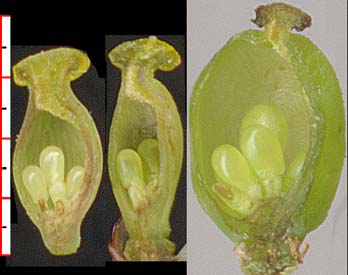 |
Transverse cut of distal inner surface of
B. swaseyi (left) & B. trifoliolata carpels |
Longitudinal cut of B. trifoliolata (left) & B. swaseyi carpels |
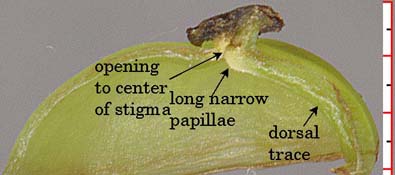 |
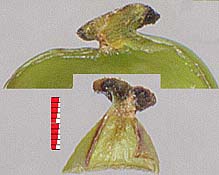 |
| Distal cut of B. swaseyi carpel |
Distal cut of hybrid carpel |
The Dorsal Trace
At maturity the dorsal trace is distinctively different in the two species: narrower and thicker with B. trifoliolata; broader and less prominently raised with B. swaseyi. Hybrids tend to fall into either type. But given the larger size of the hybrid fruits, a dorsal trace of the B. trifoliolata type is even more prominent.
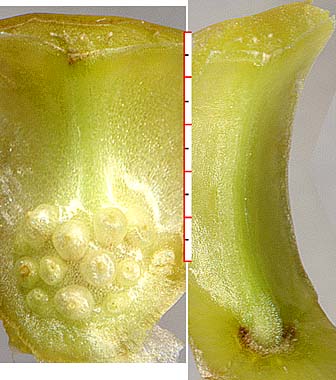
|
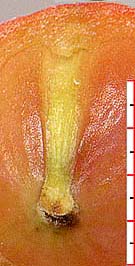
|
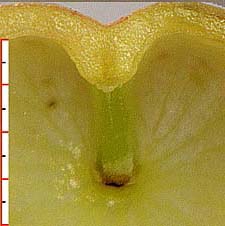
|
|
B. swaseyi
|
B. trifoliolata
|
Hybrid (H11)
|
Transverse cuts of mature size carpels showing the dorsal trace.
Style-stigma area at the bottom (right). Placenta with funiculi at left for B. swaseyi.
|
The Style – Pericarp Connection
At anthesis there is no clear difference in style length, which ranges in length from 0.2 to 0.48 mm. But in the process of maturing the carpel of B. swaseyi expands to fully encompass the style, thus becoming estylose with few exceptions, unlike B. trifoliolata, which remains sylose. The hybrids show considerable variation, but carpel enlargement alone is not sufficient to absorb the style.
The berries of B. swaseyi are generally somewhat hollow, somewhat inflated. When fully ripe, as the pericarp expands, its attachment to the stigma ruptures and the stigma is often completely torn loose. This never happens with B. trifoliolata, and is rare with even the largest fruits of hybrid plants.
A similar development was noted for B. haematocarpa by Purpus 1893 (p. 361; cited by Fedde 1901 and quoted virtually verbatim):
Die Samen sind länglich oval, ... und stehen frei in unregelmässiger Anzahl von ca. 8-18 auf dem Fruchtboden, von dem sie sich nach der Reife loslösen und durch die von dem abfallenden Griffelansatz sich bildende Oeffnung herausfallen.
The seeds are elliptical, ... and stand free in irregular number from c. 8-18 on the carpel base, from which they come loose when ripe and fall out through the opening formed by the deciduous style rudiment.
[In one place Fedde replaces Purpus' Griffelansatz with Narbe 'stigma,' but retains the original wording in the above, thus literally 'style rudiment.']
In other words, the rupture at the style/stigma interface may well be a rudimentary form of dehiscence, although with B. swaseyi the berries fall off long before the opening is developed to the extent Purpus notes for B. haematocarpa.
Funiculi
Funiculi are distinctly different in the two species. (1) Those of B. swaseyi are relatively uniformly short and round (0.2 – 0.7 mm); those of B. trifoliolata vary within the same carpel from short to elongated (0.2 – 1.8 mm), with a wider apex. (2) Those of B. swaseyi are round; those of B. trifoliolata clearly 3–5lobed (with a few exceptions). The clear hybrids tend to have either one or both of the B. trifoliolata features.
The Number of Ovules
I did not find a significant difference in the number of ovules per carpel at anthesis, roughly (6-) 8-12 (-14), as may be apparent from the number of funiculi in the above placental images. The number of seeds in the smaller B. trifoliolata fruits was roughly 2 less than for B. swaseyi and the hybrids.
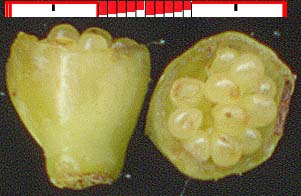
|
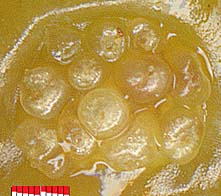
|
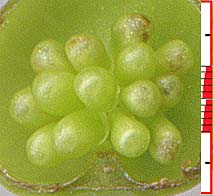
|
|
B. trifoliolata: 11 ovules in bud
|
B. swaseyi: 13 ovules
|
Hybrid H1: 14 funiculi
|
Cf. also the discussion of seeds.

